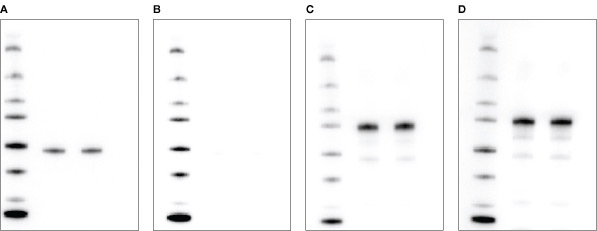Membranes that have been used in noncolorimetric immunodetection methods such as chemiluminescent or fluorescent techniques can be stripped of antibodies for use in subsequent rounds of Western blot detection. This allows the same blot to be probed for different proteins and saves both time and sample material. This section provides some tips for stripping and reprobing membranes used in Western blotting.
Related Topics: Antibody Selection and Dilution, Detection Methods, Western Blotting.
Page Contents
Blots can be stripped and reprobed several times but each round of stripping removes some sample from the blot. This decreases the sensitivity of subsequent rounds of detection and may necessitate longer exposure times or more sensitive detection methods.
When reprobing a blot multiple times:
- If detecting proteins of different abundance or when using antibodies with very different binding affinities, first detect the protein with the lower expected signal sensitivity
- Comparisons of target protein abundance among different rounds of detection is unreliable, as some sample is removed during the stripping process
- PVDF membranes are recommended because they are more durable and resists loss of sample better than nitrocellulose membranes
- After stripping a blot, test for complete removal of the antibody. If chemiluminescent detection methods were used, removal of the secondary antibody can be confirmed by incubation with fresh chemiluminescent substrate. Primary antibody removal can be confirmed by incubation with an HRP-labeled secondary antibody followed by incubation with fresh chemiluminescent substrate. If remaining antibody is detected using these tests, re-strip the blot before subsequent experiments

Stripping and reprobing PVDF membranes. E. coli lysate containing human transferrin and a GST-tagged protein was loaded on a gel and blotted onto PVDF membranes. (A), the blot probed with an anti-GST antibody and developed with Immun-Star™ WesternC™ chemiluminescent substrate. (B), the same blot subsequently stripped of antibody and reprobed with the secondary antibody and developed with chemiluminescent substrate to demonstrate removal of primary antibody. This blot was also reprobed with StrepTactin-HRP to visualize the ladder. (C), the stripped blot reprobed with an anti-human transferrin antibody. (D), a control blot that did not undergo the stripping procedure probed with the anti-human transferrin antibody.
Related Content
TEST
| Number | Description | Options |
|---|---|---|
| 6216 | Detection Buffer Formulations | Click to download |
| 6218 | Blot Stripping & Reprobing | Click to download |
